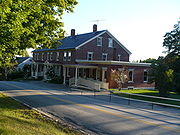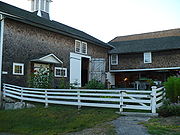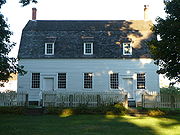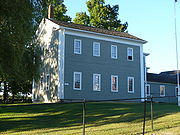
Canterbury shaker village
Encyclopedia
Canterbury Shaker Village, is a historic site and museum in Canterbury, New Hampshire
. It was one of a number of Shaker
communities founded in the 19th century.
It is one of the most intact and authentic surviving Shaker community sites, and was declared a National Historic Landmark
in 1993.
The site is operated by a non-profit organization established in 1969 to preserve the heritage of the Canterbury Shakers. Canterbury Shaker Village is an internationally-known, non-profit museum and historic site with 25 original Shaker buildings, four reconstructed Shaker buildings and 694 acres (2.8 km²) of forests, fields, gardens and mill ponds under permanent conservation easement. Canterbury Shaker Village "is dedicated to preserving the 200-year legacy of the Canterbury Shakers and to providing a place for learning, reflection and renewal of the human spirit."
Visitors learn about the life, ideals, values and legacy of the Canterbury Shakers through tours, programs, exhibits, research and publications. Village staff, largely volunteer, conduct tours and its restaurant serves traditional Shaker lunches and dinners spring, summer and fall.
of Enfield, New Hampshire
. A bishopric was composed of two or more communities in the same area or geographical location. They were designed as a way to organize communications and events amongst villages and acted as an administrative unit, which represented the governing body of the United Society of Believers.
In 1782 Israel Chauncey and Ebeneezer Cooley from the Mount Lebanon village of Shakers traveled to Canterbury and converted several prominent figures of the community. These figures included Benjamin and Mary Whitcher and the Wiggin and Sanborn families, who later donated land to house the Canterbury Village community of Shakers. Through a donation of land from local community members, the Canterbury Village was founded in 1792. The village expanded over time and in 1850 the site contained 3000 acres (12.1 km²) with a community of 300 housed in 100 buildings.
The Shakers were organized in a hierarchical system of four levels. The first level to which every member of the community was involved in was the family. Above the family were members known as elders and eldresses, deacons and deaconesses. The third level usually consisted of two men and two women who formed a ministry, which governed over the individual communities. Finally, the fourth level was the bishopric, which governed the local communities.
In 1901 the New England Telephone Company installed telephones at the Canterbury Village site. As Stein outlined this would have changed community life in the sense that the installation of the telephone eradicated the need for long distance travel between Shaker communities.
The Canterbury Village had its own powerhouse, which was constructed in 1910. The cost of the powerhouse was $8,000 and at first, the generator powered the electric lights in sixteen community buildings. The Canterbury members were also given a television set after its invention in the 1950s by friends of the community.
The Shakers of Canterbury also had laborsaving inventions of their own, which contributed greatly to their economy. The Canterbury Shakers patented a washing machine, an accomplishment that was recognized by mainstream society in the form of a gold medal at the Centennial Exposition
in 1876.
Music was also an important part of Shaker life at Canterbury. Among the many Canterbury Shaker spirituals are the hymn, "Celestial Praises" from 1841, and the song, "We Will All Go Home With You" from 1862. Between 1842 and 1908 there were eleven different Shaker hymnals published by the Shakers at Canterbury.
Canterbury, New Hampshire
Canterbury is a town in Merrimack County, New Hampshire, United States. The population was 2,352 at the 2010 census. Canterbury is home to Ayers State Forest and Shaker State Forest. On the last Saturday in July, the town hosts the annual .- History :...
. It was one of a number of Shaker
Shakers
The United Society of Believers in Christ’s Second Appearing, known as the Shakers, is a religious sect originally thought to be a development of the Religious Society of Friends...
communities founded in the 19th century.
It is one of the most intact and authentic surviving Shaker community sites, and was declared a National Historic Landmark
National Historic Landmark
A National Historic Landmark is a building, site, structure, object, or district, that is officially recognized by the United States government for its historical significance...
in 1993.
The site is operated by a non-profit organization established in 1969 to preserve the heritage of the Canterbury Shakers. Canterbury Shaker Village is an internationally-known, non-profit museum and historic site with 25 original Shaker buildings, four reconstructed Shaker buildings and 694 acres (2.8 km²) of forests, fields, gardens and mill ponds under permanent conservation easement. Canterbury Shaker Village "is dedicated to preserving the 200-year legacy of the Canterbury Shakers and to providing a place for learning, reflection and renewal of the human spirit."
Visitors learn about the life, ideals, values and legacy of the Canterbury Shakers through tours, programs, exhibits, research and publications. Village staff, largely volunteer, conduct tours and its restaurant serves traditional Shaker lunches and dinners spring, summer and fall.
Origins of Canterbury Shaker Village and the New Hampshire Bishopric
The Canterbury site was one of two communities existing in what was known as the New Hampshire Bishopric. The New Hampshire bishopric contained Canterbury village and the Shaker villageEnfield Shaker Museum
The Enfield Shaker Museum is a museum and historic site in Enfield, New Hampshire, USA. It is dedicated to preserving and sharing the history of the Shakers, a Protestant religious denomination, who lived on the site from 1793 to 1923. The museum features exhibitions, artifacts, eight Shaker...
of Enfield, New Hampshire
Enfield, New Hampshire
Enfield is a town in Grafton County, New Hampshire, United States. The population was 4,582 at the 2010 census. The town includes the villages of Enfield, Enfield Center, Upper Shaker Village, Lower Shaker Village, Lockehaven, and Montcalm....
. A bishopric was composed of two or more communities in the same area or geographical location. They were designed as a way to organize communications and events amongst villages and acted as an administrative unit, which represented the governing body of the United Society of Believers.
In 1782 Israel Chauncey and Ebeneezer Cooley from the Mount Lebanon village of Shakers traveled to Canterbury and converted several prominent figures of the community. These figures included Benjamin and Mary Whitcher and the Wiggin and Sanborn families, who later donated land to house the Canterbury Village community of Shakers. Through a donation of land from local community members, the Canterbury Village was founded in 1792. The village expanded over time and in 1850 the site contained 3000 acres (12.1 km²) with a community of 300 housed in 100 buildings.
The Shakers were organized in a hierarchical system of four levels. The first level to which every member of the community was involved in was the family. Above the family were members known as elders and eldresses, deacons and deaconesses. The third level usually consisted of two men and two women who formed a ministry, which governed over the individual communities. Finally, the fourth level was the bishopric, which governed the local communities.
The influences of modernization on the Canterbury Village Shakers
Over the period in which the Canterbury Village existed as a working Shaker community, various inventions from mainstream society were adopted by its members. As Stephen Stein highlights in his definitive guide to the Shaker society, The Shaker Experience, “New means of transportation, sources of power, complex machinery, and communication devices transformed community life and came to symbolize the views of modern Believers.”In 1901 the New England Telephone Company installed telephones at the Canterbury Village site. As Stein outlined this would have changed community life in the sense that the installation of the telephone eradicated the need for long distance travel between Shaker communities.
The Canterbury Village had its own powerhouse, which was constructed in 1910. The cost of the powerhouse was $8,000 and at first, the generator powered the electric lights in sixteen community buildings. The Canterbury members were also given a television set after its invention in the 1950s by friends of the community.
The Shakers of Canterbury also had laborsaving inventions of their own, which contributed greatly to their economy. The Canterbury Shakers patented a washing machine, an accomplishment that was recognized by mainstream society in the form of a gold medal at the Centennial Exposition
Centennial Exposition
The Centennial International Exhibition of 1876, the first official World's Fair in the United States, was held in Philadelphia, Pennsylvania, from May 10 to November 10, 1876, to celebrate the 100th anniversary of the signing of the Declaration of Independence in Philadelphia. It was officially...
in 1876.
Music was also an important part of Shaker life at Canterbury. Among the many Canterbury Shaker spirituals are the hymn, "Celestial Praises" from 1841, and the song, "We Will All Go Home With You" from 1862. Between 1842 and 1908 there were eleven different Shaker hymnals published by the Shakers at Canterbury.
Buildings
 |  |  |
 |  | |
External links
- Canterbury Shaker Village - official website
- Shaker Music - at American Music Preservation.com
- Shaker Historic Trail: A National Register of Historic Places Travel Itinerary

